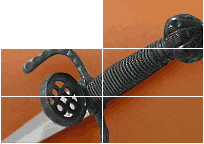Tod's Stuff Low Countries Ballock Dagger
Original: Early 16th Century

We find that
ballock daggers first appeared in historical iconography, sculpture, and other artwork at the start of the 14th century. The name is derived from the fact that its general form is influenced by the shape of the male
phallus. Later examples of these daggers became more anatomically ambiguous in shape but still retained the characteristic lobes at the base of the grip and were of a more stylized form. By the middle of that century, these fully-developed forms started to make an appearance both on the European Continent and in Britain.
The antique dagger that influenced the piece featured here is thought to be from the Low Countries (modern-day Belgium, the Netherlands, Luxembourg and parts of Northern France and Western Germany) and is dated to the early 16th century. It was featured in a 2008 auction by
Christie's Auction House. The original piece is in excavated condition and has brass sunburst mounts not replicated here.
The slender blade is of flattened diamond cross-section that changes to a recessed hexagonal-sectioned ricasso. The sharply tapered blade ends with an acute point. The hand-carved grip is made of elm wood and is mounted with a brass pommel cap scalloped at its edges and hammered over the end of the grip. A shaped brass plate sits where the grip meets the blade. On one side, a maker's mark is struck into the ricasso near the hilt.
The scabbard is constructed of two layers of leather carefully formed to hold the blade. The seam is stitched up the back. An integral thong sits within a channel near the mouth. The brass chape is finished with a detailed decorative element resembling an acorn.
Overall length: 16.375"
Weight: 8 ounces
Blade: 11.375" long; .75" wide tapering to .1875"
Hilt length: 5"
Maker:
Tod's Stuff of Oxford, United Kingdom.

This piece is inspired by an example from the early 16th century now located in a private collection.



 This piece is inspired by an example from the early 16th century now located in a private collection.
This piece is inspired by an example from the early 16th century now located in a private collection.